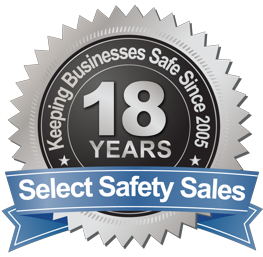Your shopping cart is currently empty.
Effects of Chemical Splashes in the Eyes
Damage to the Eye Can be Caused by Both Acidic and Alkaline Chemicals

Having either an acidic or alkaline chemical sprayed or splashed in the eye can cause severe damage to the delicate tissue of the eye. An acidic chemical will usually cause damage to the surface of the eye while alkaline chemicals can quickly begin penetrating the inner chambers of the eye.
Both Acidic and Alkaline Chemicals Have the Potential to Cause Blindness.
An acidic chemical will cause protein to coagulate in the corneal epithelium. This can limit further penetration of the chemical but it still can cause significant damage to the cornea. With this being said, not all acidic chemicals stay on the outer surface of the eye such as hydrofluoric acid which still has the ability to penetrate the cell membranes. Alkaline chemicals can quickly pass into the inner chamber of the eye exposing the entire structure of the eye to destruction. Cellular death can occur with an alkaline chemical.
The First Few Minutes are CRITICAL
A chemical splash or spray in the eye is considered an emergency because severe damage to eye tissue starts happening immediately. Irrigation of the eye is ALWAYS considered the number one treatment in this type of situation. An Eyewash Station should be strategically located within a facility where workers are exposed to hazardous chemicals. ANSI standards require that it is located within 10 seconds walking distance to assure that the worker is able to start the irrigation process as quickly as possible.
Dilute the Chemical and Wash it Away
Chemicals need to be diluted and fully washed away because damage is continuously happening the longer that any trace of the chemical is left in the eye. ANSI standards require that the victim flushes the eye for a full fifteen minutes for the best possible short and long term outcome in this type of emergency.
Chemical Splashes or Sprays can Occur in Various Forms
Chemical splashes and sprays to the eyes can occur in many forms such as liquids, gases, mists, vapors and even fumes and aerosols.
Contact Lenses and Chemicals
Wearing contact lenses while working around chemicals can cause additional problems if a splash gets into the eye. The contact lenses can further trap the chemical. If contact lenses are in an eye that has been splashed or sprayed with a hazardous chemical, start flushing immediately and if possible remove contact lenses concurrently.
It All Depends on the PH
The Alkalinity or Acidity of a chemical is called the pH. The pH is measured on a scale from one to fourteen. Neutrality of a chemical is right in the middle at number seven. Less than seven is considered Acidic and greater than seven is considered alkaline. When looking at the properties of a chemical, the higher or lower away from seven, the more damage that the chemical can cause to the eye.
MSDS Sheets and NIOSH Pocket Guides
MSDS Sheets are references for information on chemicals that are used in the workplace. In the health hazard section of the sheet, the chemical properties are indicated along with data on the chemicals potential to cause damage to the eye. MSDS sheets should be on hand in the workplace for each chemical that is used in the facility. The MSDS sheet’s first aid section will refer to the treatment that should be used for exposure of the eyes to the chemical. If irrigation of the eyes is listed as the treatment, then there should be an eyewash station available in the facility.
Safety Glasses, Safety Goggles and Eyewash Stations
Chemical Hazards in certain workplaces cannot be completely eliminated. Engineering controls, the proper PPE and the necessary safety equipment is the best line of defense to keep employees safe when working with these substances. When employees are working with caustic chemicals that can splash or spray in their eyes, they should be wearing safety glasses or goggles as their first line of defense to protect their eyes. An eyewash station needs to be in place as the second line of defense in case an accident happens. Continuous hazard assessments along with worker training can help to prevent major disabilities in these environments.
Do you work with caustic chemicals? Browse our selection of eyewash stations for protection.
References:
Ophthalmologic Approach to Chemical Burns- J. Bradley Randleman April 29, 2013
PubMed- Work-related eye injuries and illnesses- University of Arizona Colleges of Medicine and Public Health April 2007
Pub-Med-The consequences of delayed intervention when treating chemical eye burns. Oct 2007
NIOSH- Current Intelligence Bulletin 59-2005 Contact lens use in a chemical environment
Ophthalmologic Approach to Chemical Burns- J. Bradley Randleman April 29, 2013
PubMed- Work-related eye injuries and illnesses- University of Arizona Colleges of Medicine and Public Health April 2007
Pub-Med-The consequences of delayed intervention when treating chemical eye burns. Oct 2007
NIOSH- Current Intelligence Bulletin 59-2005 Contact lens use in a chemical environment
The information on this page is an original copyrighted article. We welcome you to link this page from your website. However, copying this article or illustrations in whole or in part is strictly prohibited.
Disclaimer:
We have provided this article as general information on the use of this
article. We make no claims as to the accuracy or completeness of the
information as it may apply to an infinite amount of conditions and
situations. It is the responsibility of the person or persons reading
and using this information to refer to the instructions and information provided by the manufacturer in the product package before testing or using this product. Users of this information agree to hold Select Safety Sales LLC harmless from liability of any kind relating to the use of this information.





